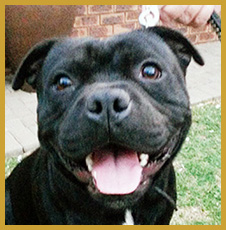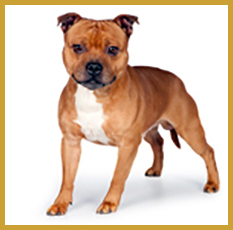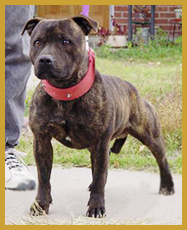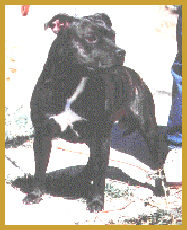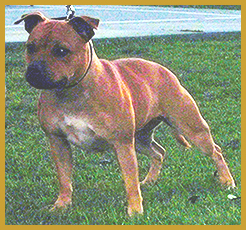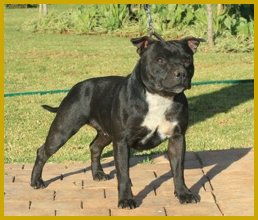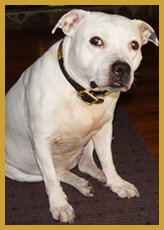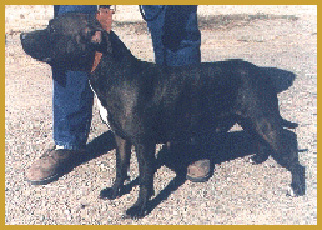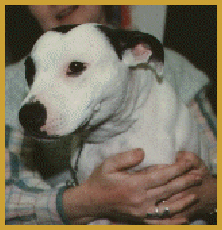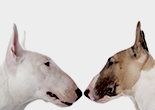FAQ - About Staffords
By Carolyn Stewart
Listed below are some of the most frequently asked questions about the Staffordshire Bull Terrier. We hope the answers help you in your decision.
-
What is the difference between the Staffordshire Bull Terrier, the American Staffordshire Terrier and the American Pit Bull Terrier?
All of these dogs are genetically the same breed. The obvious difference is in size. The Staffordshire Bull Terrier, is 14" to 16" in height, and 24 to 38 pounds. Ears are uncropped. All colors are acceptable, with the exception of black and tan and liver which are to be disqualified in the showring.
The American Staffordshire Terrier, or Amstaff, is 18" to 19" in height with weight in proportion to height. Ears are cropped or uncropped. All colors are acceptable with the exception of all white, or more than 80% white, black and tan and liver color not encouraged.
The American Pit Bull Terrier, or APBT, can range from 14" to 19" in height. The ears are cropped or uncropped. Color is of no importance. The ancestry of the Amstaff and the APBT have one breed in common, the Staffordshire Bull Terrier.
The original Pit Bull Terrier was imported by the English, and later by the Irish immigrants, who brought their dogs and their tradition of blood sports with them to America. Old records indicate that dog fighting was alive and well, as early as 1775. At various times these dogs were called Bull Dog, Bull Terrier, Bull and Terrier, Half & Half, Pit Dog, Yankee Terrier, American Bull Terrier and the Pit Bull Terrier.
From the time the Pit Bull Terrier was introduced to America, it was crossed with various fighting terriers. Their breeders, following the tradition of secrecy, kept no written records, such as pedigrees, and refused to sell to the general public.
As late as 1897 the controversy over Pit Bull family trees continued. Since the dog was known by so many names the public thought them to be separate breeds.
In 1898, C. Z. Bennett set up a stud registry called the United Kennel Club (UKC). It was a registry exclusively for Pit Bulls. The Pit Bull Terrier was chosen as the official name. Now, breeders had a way to formally keep track of their dog's family tree. Eventually, this kennel club began to recognize other breeds.
In 1909 another registry for Pit Bulls was formed by Guy McCord, called the American Dog Breeders Association (ADBA), and it emphasized preserving the original gameness of the breed.
In England, Joe Dunn and other British breeders were campaigning for recognition of the Pit Dog by the English Kennel Club. In 1935 they gained official recognition. They chose to name their dogs the Staffordshire Bull Terrier, after the Black Country where the dog had been bred for centuries.
In America at the same time, a group of Pit Bull breeders were attempting to gain recognition from the American Kennel Club (AKC). They felt that the unsavory reputation of the Pit Dog was impeding the acceptance of the dog by the public. When the AKC granted their petition, a part of the Pit Bull population became known as the Staffordshire Terrier.
Although they are genetically the same dogs, the different paths they have taken since the 1930's have made them separate breeds.
-
How is their temperament?
Staffords are very intelligent, affectionate and trustworthy. They possess the most stable disposition of all dogs.
-
How are they with people and children?
Gentle and affectionate by nature, and at his best with children. He is also intelligent, and amiable to training and discipline. The Stafford is unsurpassed as a family companion.
-
How are they with other dogs and cats? We have an older dog/cat at home.
When introduced as a puppy into a home with an established pet, they can do quite well. Two male Staffords in the same household can eventually lead to a problem. Raising two females or dogs of the opposite sex is the best recommendation.
Due to their past history, Staffords can be aggressive towards other dogs or animals, so introducing an older dog into a home with resident pets should be handled with great care. It is always wise to discuss these concerns with an experienced breeder.
-
How are they around strange dogs or other animals?
Socialization is the key to prevention. Take your new puppy for walks around the neighborhood or to a park. Allow him/her to meet other dogs, people and animals at a young age. Obedience classes are a bonus, and can be great fun for both you and your pet. A Stafford should never be allowed to wander free off the leash and out of your control.
-
Do they need a lot of exercise?
A Stafford needs more exercise than your average dog. They possess a tremendous amount of energy and an active mentality. A rigorous few minutes every day is essential to a Stafford's well being. This can be accomplished by a little rough housing, a game of fetch the ball, or tug-o-war. They love vigorous walks, jogging or running alongside a bicycle or horse. Whatever you choose your Stafford will be more than willing to participate.
-
Are they noisy dogs?
Unlike other terrier breeds, the Stafford is not prone to constant barking or yipping. They may bark to attract your attention, if they need to go out, want to play, or when the neighbor's cat enters your yard.
-
Are they good guard dogs?
Yes, but they should not be compared to a Doberman or a dog that was bred specifically for this purpose. The Stafford maintains a quiet vigil, but will not hesitate to warn you when strangers are approaching. They are naturally protective of their family, and will rise to the occasion if necessary. Following is my own experience with our male Stafford, Hondo.
We live on three acres in a relatively secluded area, and when the door bell rang, I answered it to find a large man standing on the porch. He asked if he could come in and use the telephone, his car was not running, and he needed to call someone. I offered to call someone for him. He declined the gesture, and took hold of the screen door handle.
From his place on the couch, the sleeping dog appeared. Snarling, he hit the door with such a force, I thought for sure he bad gone through the screen door. In the confusion, I looked up to find that the door was still there, but the man was gone.
-
Should I get a male or a female?
Both make wonderful pets. We suggest that you spay or neuter your dog, as this will eliminate the inconvenience of the bitches heat, and the annoyance of an intact male yearning for romance.
-
What sorts of toys are safe to give my Stafford?
There are no such things as "indestructible dog toys" for Bull and Terrier breeds. But some have tried these: large Nylabone products and Kong toys with some success. Anything else might be chewed up, swallowed or destroyed in short order.

Elly trying to get a treat out of a kong toy. She figured this out all on her own: upside down, shake the treat to the hole and nip the darn thing out of there. Smart as a whip. Rugar would just try to rip it apart.
